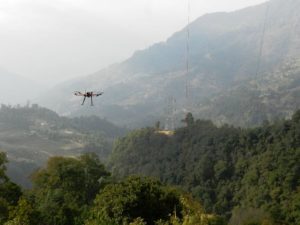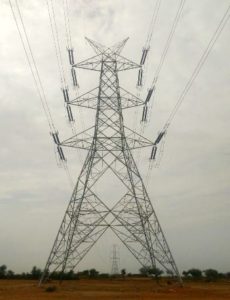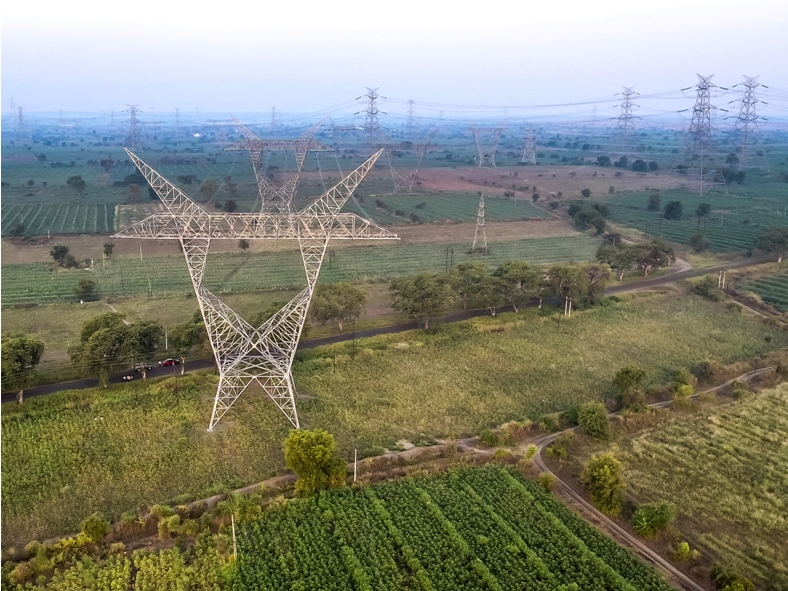Augmenting power transmission capacity is one of India’s foremost objectives as the country strives to transfer an ever growing quantum of power—from generation centres to far-flung consumption areas. Laying overhead power transmission lines is a highly land-centric activity, which is often fraught with difficulties and unpleasant surprises. T&D India got in touch with leading power transmission contractors to understand the ground-level challenges and how the fraternity is working towards surmounting them.
India has planned to invest Rs.2,54,000 crore (around $37 billion) in its power transmission infrastructure during the period 2017-22. Nearly 90 per cent of this would go towards the above220kV grid. The physical target for the period is around 1 lakh ckm of power transmission lines and 3.3 lakh MVA of transformation capacity. This target includes HVDC power transmission infrastructure corresponding to 14,000 mw capacity. In the past five years (FY14 to FY18), around 1.16 lakh ckm of transmission lines and 3.5 lakh MVA of transformation capacity has been added. This clearly shows that in the next five years, the achievement of the past five years will be replicated.
In the context of India’s power transmission ambitions, T&D contractors have a very critical role. Power transmission is a land-centric activity and as such, all the difficulties associated with an already-difficult subject like “land” come into play. Dealing with land-related issues has never been easy in a country like India. Apart from ownership-related issues, India’s diverse landforms that could include dense forests, hilly terrain, water bodies, etc pose physical challenges as well.
KEC generally undertakes projects as contractors, so basic approvals, including environmental clearances are secured by the developers. Having said that, we are beginning to see greater efforts by the government in supporting policy rollouts such as land (and crop) compensation. However, the actual impact on ground is incremental. Issues such as non-clarity on discretionary elements of supporting policies, and problems caused due to influential landowners, still exist. We are seeing some improvements in issues, such as faster forest clearances. However, further improvement is needed on matters related to RoW, land acquisition, road/rail approvals, etc.
Securing right-of-way is considered as the biggest impediment while planning and executing power transmission projects, especially overhead lines. India is moving to extra high voltage (EHV) and ultra high voltage (UHV) lines so as that more electricity can be transmitted with using the same geographical footprint. For interregional lines, 765kV has since long become the norm and today this voltage is considered even for intrastate lines.
According to Vimal Kejriwal, MD & CEO, KEC International, innovative tower designs and digital interventions have greatly helped in reducing the transmission corridor. Narrow towers and monopoles that have a small base are being increasingly used. This reduces the requirement of land. Besides, HTLS (high-temperature, low sag) conductors are replacing conventional conductors. These conductors are light and have the capacity to carry more power. Their lightness requires transmission towers to have a smaller base, thereby reducing the land footprint, notes Kejriwal.
 Speaking to T&D India, D.C. Bagde, CMD, Transrail Lighting Ltd, said, “When it comes to right-of-way it finally boils down to how much corridor you can reduce. There are two ways of achieving this. The first is to take transmission lines on monopoles. The second is to replace conventional cross-arms and go in for insulated fibre-glass cross-arms.”
Speaking to T&D India, D.C. Bagde, CMD, Transrail Lighting Ltd, said, “When it comes to right-of-way it finally boils down to how much corridor you can reduce. There are two ways of achieving this. The first is to take transmission lines on monopoles. The second is to replace conventional cross-arms and go in for insulated fibre-glass cross-arms.”
Concurring with this view was Subhash Sethi, Chairman, SPML Infra. According to Sethi, nowadays narrow-based multi-circuit towers are now available even for EHV lines. Such towers take lesser area for foundation and also reduce the project gestation period. Even for EHV substations, gas-insulated switchgear (GIS) is preferred over the conventional air-insulated substation (AIS), resulting in much lesser geographical footprint, observes Sethi.
When transmission lines pass over sensitive areas like agricultural fields, there are greater difficulties than just securing right of way. It is the potential damage caused to the land during construction, including the stringing phase. It is here that technology has come to rescue. It is not just the lines that are overhead even the stringing activity has become overhead—thanks to the use of drones or unmanned aerial vehicles (UAV). Stringing is the activity of securing power conductors on transmission towers.
According to P.K. Paine, COO – T&D, Sterling and Wilson, aerial technology in which helicopters are used for stringing is gaining currency in India. Such technology is quite commonplace overseas. “This technology can easily reduce the number of approvals required and can be done without damaging the land,” notes Paine.
Although during last few years, Indian industry has improved substantially in terms of project completion including quality and safety still there is long way to go to increase the use of mechanisation in foundation, tower erection and stringing if they have to complete with global players. We need to improve the facilities offered to our manpower at site and the client should set standards by having stringent requirement in the specifications. Use of LiDAR technology for survey and use of helicopter for erection and drones for stringing will bring down completion timelines and also reduce accidents. Moreover, it would have lesser environmental impact.
—D.C. Bagde, CMD, Transrail Lighting Ltd
Kejriwal of KEC stressed on the use of technology to surmount land-related impediments. “We use UAV/drones to string power conductors, which have been especially beneficial in hilly terrains as it minimizes the damage caused to the environment. We use advanced survey techniques such as LiDAR (Light Detection and Ranging) in inaccessible and difficult sites, which helps in precision planning, enabling us to minimize our footprint and damage caused to the ecosystem, while also leading to efficient project management,” he elaborated.
Expediting clearances
Land-related issues are not limited to the construction phase. Even before the first pour of concrete, overhead power transmission lines need to deal with several clearances. Securing these clearances does not strictly fall within the purview of the contractor but is more within the domain of the developer (owner of the transmission line.) All the same, contractors are affected as timely clearances always mean faster project implementation and, in turn, faster return on investment to the developer.
Much of India’s power transmission infrastructure still lies within the public sector ambit—both Central and state—although private sector developers are fast making their presence felt. Securing mandatory clearances and obtaining right-of-way (RoW) has traditionally been a contentious issue. When transmission lines pass through ecologically sensitive areas like forests, the clearance process can get further delayed. Has there been any improvement on the right-of-way and clearances front was the question posed to the participating T&D contractors; the response was mixed. Much has been done but there is more to do was the general perception conveyed.
Vimal Kejriwal acknowledged that there was some visible progress such as faster forest clearances. The government is also supporting policy rollouts that address land-related issues—crop compensation schemes, for instance. All said, “There is still non-clarity on discretionary elements of supporting policies and problems caused due to influential landowners still exist,” cautioned Kejriwal.
There is no doubt after the new government established in 2014; it has initiated several initiatives and policies for the development and improvement of power sector. Through series of notifications, the environment ministry has eased rules for mining, roads, power and irrigation projects and diluted a host of regulations related to environment, forest and tribal rights for easy implementation of projects. The necessary approval from Railways, National Highways Authority of India and other government authorities has become smooth for power transmission projects. Major policy is formulated or amended, like Electricity Act, Tariff Policy, formulation of National Electricity Plan, and standard bidding documents (SBDs) for carrying out competitive bidding for procurement of power transmission services etc. The Electricity (Amendment) Bill, 2014 have a profound impact on the Indian power sector.
—Subhash Sethi, Chairman, SPML Infra Ltd
Subhash Sethi of SPML Infra was clearly appreciative of the government’s effort. “Through a series of notifications, the environment ministry has eased rules for mining, roads, power and irrigation projects and diluted a host of regulations related to environment, forest and tribal rights for easy implementation of projects. Securing necessary approvals from Indian Railways, National Highways Authority of India and other government authorities, has become smooth for power transmission projects,” was how Sethi put it. The SPML Infra Chairman strongly felt that the new NDA government, after coming to power in 2014, has initiated several reforms in the power sector, which have been addressing various issues quite closely.
Echoing the positive sentiment was P.K. Paine of Sterling and Wilson who recalled a time when almost 20 government clearances were required for transmission projects, which potentially derailed project schedules. However, matters are changing for the better. “The government has significantly reduced the number of clearances hereby enabling an easier and faster clearance process,” felt Paine.
Contrary to the popular sentiment, D.C. Bagde held the view that not much tangible has taken place on the clearances front. “There have been no tangible improvements,” Bagde asserted.
Global opportunities
Much like India, several developing nations are upgrading their power transmission infrastructure to support their growing economies. It is indeed heartening to note that equipped with rich experience in domestic projects, Indian EPC contractors are exploiting opportunities overseas. In fact, some EPC contractors have a larger share of foreign projects than domestic ones.
 KEC International, for instance, has wide exposure in the global power transmission contracting market. Vimal Kejriwal, the company’s MD & CEO, was of the view that between now and 2025, regions where significant opportunities exist in the power transmission EPC contracting space are SAARC countries, Asia, Middle East, Africa and North America. “SAARC, in particular, is a potential growth market and is expected to grow at over 20 per cent between FY18 and FY22. There are large capacity interconnections already existing between India, Bhutan, Bangladesh and Nepal, and additional high capacity lines and grid reinforcements are in the pipeline.”
KEC International, for instance, has wide exposure in the global power transmission contracting market. Vimal Kejriwal, the company’s MD & CEO, was of the view that between now and 2025, regions where significant opportunities exist in the power transmission EPC contracting space are SAARC countries, Asia, Middle East, Africa and North America. “SAARC, in particular, is a potential growth market and is expected to grow at over 20 per cent between FY18 and FY22. There are large capacity interconnections already existing between India, Bhutan, Bangladesh and Nepal, and additional high capacity lines and grid reinforcements are in the pipeline.”
Subhash Sethi of SPML Infra felt that countries where power-sector projects, including transmission, are backed by funding from World Bank or its associates, represent good business opportunities for Indian contractors. “The countries such as Afghanistan, Bangladesh and several African nations where these projects are being funded by World Bank or Asian Development Bank etc. have good opportunities for power EPC companies,” said Sethi in elaboration.
The important aspect to be looked into is whether Indian EPC contractors are generally competitive in the global market. D.C. Bagde of Transrail, while corroborating with the fact that several geographies like Africa, South East Asia, SAARC region and Eastern Europe do offer opportunities, it is not always easy going for Indian contractors. “Indian companies have to compete with other global players, especially Chinese companies, which can be a big challenge,” averred Bagde. Indian EPC contractors would do well to further improve their project execution capabilities so as to become globally competitive. “Although during last few years, Indian industry has improved substantially in terms of project completion including quality and safety still there is long way to go to increase the use of mechanisation in foundation, tower erection and stringing if they have to complete with global players,” was Bagde’s advice to the contracting fraternity.
Right of way (RoW) is one of the most significant concerns while undertaking power transmission projects. Issues of RoW can be resolved to a large extent with suitable tower design and configuration strategies. One such technology used overseas is known as aerial technology wherein helicopters are used to lay power transmission lines. This technology can easily reduce the number of approvals required and can be done without damaging the land. With the changing requirements and development of new technology, major industry players such as Sterling and Wilson are also evolving to adapt to the increasing demand.
—P.K. Paine, COO – T&D, Sterling and Wilson
On the same lines was Paine’s opinion who felt that Indian EPC contractors that are inclined to align themselves with global technology and practices stand a good chance for overseas contracts, especially South Africa, South America and even European countries where opportunities abound.
The culture difference
Most of the EPC contractors that T&D India interacted with had significant global exposure behooving one to understand how varied was the experience while executing government-backed power transmission projects in India and overseas. P.K. Paine felt that while the processes are generally more streamlined overseas, material clearances are easier in India. He also was of the view that safety norms are relatively more stringent in overseas projects and there is generally more emphasis on health and environment-related norms.
Bagde from Transrail brought out some finer aspects. He explained that in Indian projects, all design approvals are either given by the client or the clients give their own designs. As such, the client interface with the contractor is substantial. However, in most overseas projects, owned by their respective governments, consultants are given the approval of design, supervision of works, recommendation for passing of bills etc. Government agencies are involved directly only in clearing right-of-way, noted Bagde.
KEC International’s MD & CEO, Vimal Kejriwal, made a general remark that since every country has its own set of mandated rules, there would naturally be some difference whilst executing government-backed projects overseas, and back home. However, Kejriwal made a subtle observation about pace of project execution and the extant power situation in that country. For example, as Kejriwal noted, it is easier to move machinery in Africa because the region is power-starved and there is inherent need for faster execution of projects. “On the other hand, if you consider the Middle East, the pace of execution depends on the priority of the government,” remarked Kejriwal.
Featured photograph shows the 1,200kV Wardha-Aurangabad transmission line of Power Grid Corporation of India, in Maharashtra. (Project contractor and source of photograph: Transrail Lighting Ltd)



